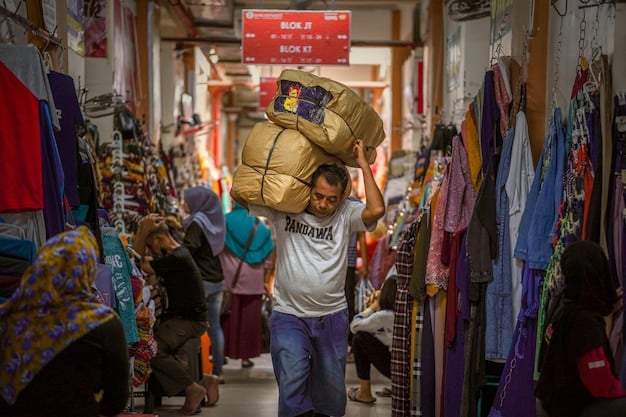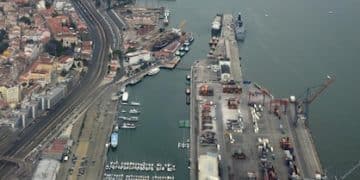Peru’s Currency Impact: Analyzing US Import Costs

Analyzing the Impact of Peru’s Currency Fluctuations on US Import Costs reveals how changes in the Peruvian sol affect the prices and competitiveness of Peruvian goods in the American market, influencing trade dynamics and business strategies.
Understanding the dynamics between Peru’s currency fluctuations and US import costs is crucial for businesses and policymakers alike. These fluctuations can significantly alter the price competitiveness of Peruvian goods in the US market, affecting trade volumes and economic relationships. This analysis delves into the multifaceted impacts of currency volatility on import costs.
Understanding Currency Fluctuations
Currency fluctuations are a common phenomenon in the global economy, influenced by factors ranging from political instability to changes in macroeconomic policies. For countries like Peru, whose economy relies significantly on exports, these fluctuations can have profound implications. Understanding these dynamics is the first step in analyzing their impact on US import costs.
The Peruvian sol, like any other currency, is subject to market forces that determine its value relative to other currencies, particularly the US dollar. These forces include interest rates, inflation, and overall economic performance.
Factors Influencing the Peruvian Sol
Several key factors influence the value of the Peruvian sol. These include:
- Interest Rate Differentials: Higher interest rates in Peru can attract foreign investment, increasing demand for the sol and thus its value.
- Inflation Rates: Higher inflation in Peru can erode the sol’s value, making Peruvian exports more expensive.
- Political Stability: Political uncertainty can lead to capital flight, weakening the sol.
- Commodity Prices: As a major exporter of commodities like copper and gold, Peru’s currency is sensitive to global commodity prices.

Understanding these factors is crucial for predicting how the sol might behave in the future and its potential impact on trade with the US. Currency fluctuations are not merely abstract numbers; they have real-world consequences for businesses and consumers.
The Direct Impact on Import Costs
The most immediate impact of currency fluctuations on US import costs is through the change in relative prices. When the Peruvian sol depreciates against the US dollar, Peruvian goods become cheaper for American importers. This dynamic directly affects the competitiveness of Peruvian exports in the US market.
For instance, if the sol depreciates by 10%, a product priced at 100 soles would effectively cost 10% less in US dollar terms. This can lead to increased demand for Peruvian goods, as they become more attractive compared to domestically produced alternatives or imports from other countries.
How Depreciation Lowers Costs
- Lower Prices for Importers: US importers can purchase Peruvian goods at a lower cost, increasing their profit margins.
- Increased Competitiveness: Peruvian products become more competitive against US-made goods and imports from other nations.
- Potential for Higher Import Volumes: Lower costs can lead to higher import volumes, benefiting both Peruvian exporters and US consumers.
However, it’s not always a straightforward benefit. While a weaker sol can boost exports, it can also increase the cost of imported inputs for Peruvian businesses, potentially offsetting some of the gains.
Specific Industries Affected
Certain industries are more sensitive to currency fluctuations than others, depending on their reliance on international trade and the nature of the goods they export or import. For Peru, key sectors include agriculture, mining, and textiles. These industries play a significant role in the country’s trade relationship with the US.
Agriculture is a major export sector for Peru, with products like avocados, asparagus, and coffee finding their way to US markets. Mining, particularly copper and gold, is another critical area, while textiles represent a significant portion of the country’s manufacturing exports.
Agriculture: A Key Export Sector
The agricultural sector is highly sensitive to currency movements. These could benefit greatly from the depreciation of the Sol:
- Avocados
- Asparagus
- Coffee

Currency fluctuations can significantly impact the competitiveness of these products in the US market, affecting both Peruvian exporters and American consumers.
US Importer Strategies
Given the potential impact of currency fluctuations, US importers need to adopt strategies to mitigate risks and capitalize on opportunities. These strategies include hedging, diversifying supply chains, and negotiating contracts that account for currency volatility. Effective risk management is essential for maintaining profitability and stability in the face of currency fluctuations.
Hedging involves using financial instruments to protect against adverse currency movements. Diversifying supply chains means sourcing goods from multiple countries to reduce reliance on any single currency. Negotiating contracts that allow for price adjustments based on currency fluctuations can also help mitigate risk.
Risk Management Techniques
- Hedging: Using financial instruments to offset potential losses from currency fluctuations.
- Diversification: Sourcing goods from multiple countries to reduce currency risk.
- Contract Negotiation: Including clauses that allow for price adjustments based on currency movements.
By implementing these risk management techniques, US importers can better navigate the challenges posed by currency fluctuations and maintain a competitive edge.
The Role of Trade Agreements
Trade agreements, such as the US-Peru Trade Promotion Agreement, play a crucial role in shaping the trade relationship between the two countries. These agreements can provide a framework for reducing tariffs and other trade barriers, promoting investment, and fostering economic cooperation. Understanding the provisions of these agreements is essential for assessing the overall impact of currency fluctuations on US import costs.
The US-Peru Trade Promotion Agreement, for example, has eliminated tariffs on a wide range of goods, making Peruvian products more accessible to US consumers. However, currency fluctuations can still impact the competitiveness of these products, even in the absence of tariffs.
Key Provisions of Trade Agreements
These agreements can have a significant impact, since they are designed for
- Reducing tariffs
- Promoting Investment
- Fostering economic cooperation
These and other benefits of the trade agreement can often be undermined by the fluctuating currency rate.
Long-Term Economic Implications
The long-term economic implications of currency fluctuations extend beyond immediate import costs. These fluctuations can affect investment decisions, trade balances, and overall economic growth in both Peru and the US. Understanding these broader implications is crucial for policymakers seeking to promote stable and sustainable economic relationships.
For example, persistent currency volatility can discourage foreign investment in Peru, as investors become wary of exchange rate risk. This can stifle economic growth and limit the country’s ability to develop its export sector.
Impact on Economic Growth
In the long term, economists believe this can affect:
- Investment decisions
- Trade balances
- Overall economic growth
Ultimately, navigating the complexities of currency fluctuations requires a comprehensive understanding of economic principles, risk management techniques, and the broader geopolitical landscape.
| Key Aspect | Brief Description |
|---|---|
| 💰 Currency Depreciation | Makes Peruvian goods cheaper for US importers. |
| 📈 Competitiveness | Enhances the competitiveness of Peruvian exports in the US. |
| 🛡️ Risk Management | US importers need strategies like hedging to mitigate risks. |
| 🤝 Trade Agreements | Agreements like US-Peru TPA affect trade dynamics despite currency changes. |
Frequently Asked Questions
▼
When the Peruvian sol weakens against the US dollar, it becomes cheaper for US importers to buy Peruvian avocados. This can result in lower prices for consumers in US grocery stores.
▼
Hedging is a financial strategy used to protect against potential losses from currency fluctuations. It allows US importers to lock in exchange rates, providing certainty in their import costs.
▼
The agriculture, mining, and textile industries are particularly sensitive to currency fluctuations due to their significant export volumes to the US. Changes impact competitiveness and profitability.
▼
The agreement reduces tariffs and trade barriers. However, currency fluctuations can still impact the final cost, altering competitiveness even when duties are eliminated.
▼
Yes, a strong sol makes Peruvian goods more expensive for US buyers, potentially reducing demand and harming its export economy if prices become too high for importers.
Conclusion
In conclusion, analyzing the impact of Peru’s currency fluctuations on US import costs reveals a complex interplay of economic factors that significantly affect trade dynamics. Understanding these fluctuations and implementing strategic risk management techniques are essential for both Peruvian exporters and US importers to navigate the challenges and capitalize on opportunities in this ever-changing economic landscape.





